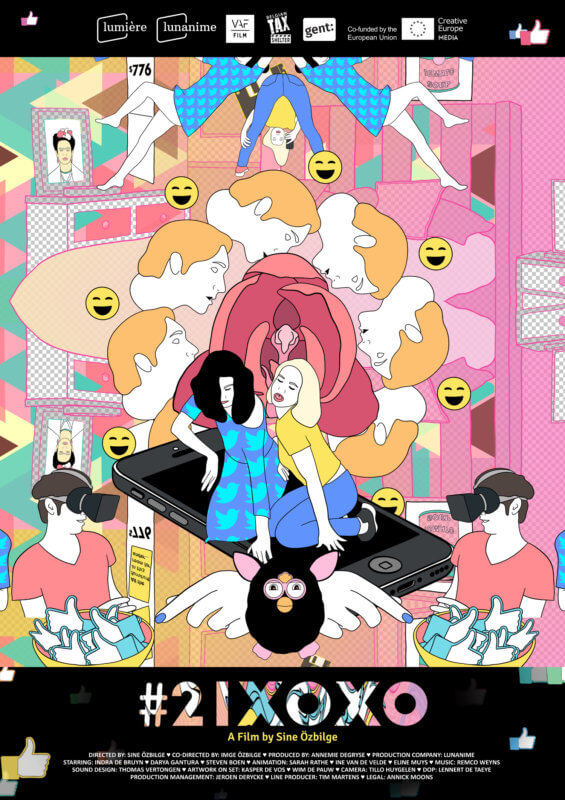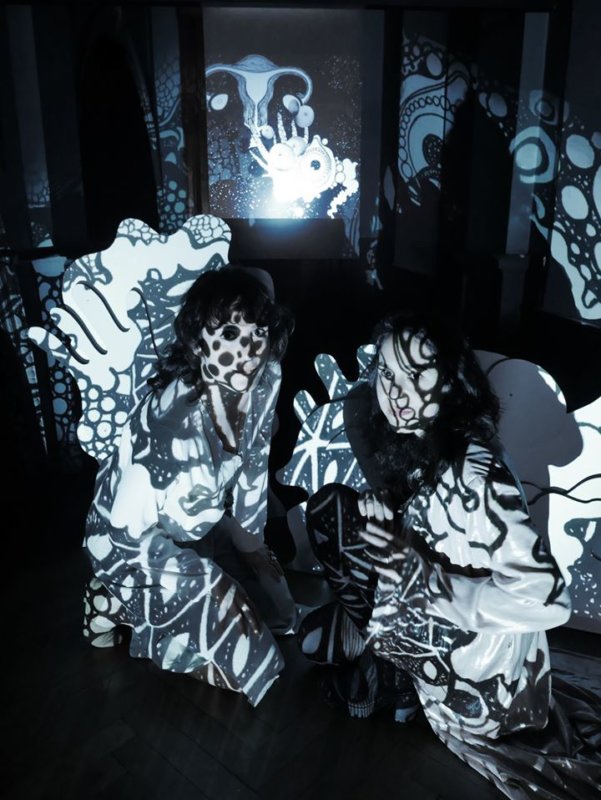Interview with Sine and Imge Özbilge (#21xoxo)
Among this year’s most talked-about new short films is the ambitious and hallucinatory #21xoxo, marrying a snapshot of dating in the modern age with a miasma of pop culture references, retro visual approaches, live-action rotoscopy, psychedelic colour palettes and sharp observational wit. In recent months the film has been a force on the festival circuit, picking up awards at the Banjaluka International Animated Film Festival and Canlandıranlar Film Festival.
With recent UK screenings including Bristol’s Encounters Film Festival, the BFI London Film Festival and our own Skwigly Screening at the Manchester Animation Festival, the film will also be part of the London International Animation Festival’s official selection at the end of the month. Skwigly caught up with Sine and Imge Özbilge, the creative duo behind the film, to learn more about their art and process.
Can you tell us a bit about yourselves and what has steered you toward the arts/filmmaking?
So to give a short introduction, we are Sine Özbilge & Imge Özbilge, a sisters duo who share the same passion in directing animation films. We have a nomadic multicultural background and are currently settled in Belgium.
Have you always worked with one another in a creative sense or did that come later on (and what sort of working dynamic do the two of you have, and does that vary from project to project)?
Our creative process as a directors duo is quite difficult to analyse and separate at times since we are already living in the same creative hub since our childhood. Being sisters has enabled us to share and grow our creative worlds throughout time. Coming from an artistic family with a painter (our mother) and a writer (our father) in the house, has played for sure a crucial part in the choice of studying arts. Besides our practice in animated film we both also work as visual artists, exhibiting paintings, video works and animated installations. We both take inspiration from all over, but also very much from contemporary art and live-action movies for the creation of our animated movies. Imge mostly works around sociological subjects while I get inspired by human psychology. So to say, while one reflects on society the other dissects the individual. This difference in the way we perceive certain subjects is also something that works very productive when we collaborate and throw ideas together.
Our working methodology changes from project to project. Sometimes I write the story sometimes Imge does, sometimes we do it together. This depends on the needs of each project and sometimes time and space also play a factor on how roles are divided.
Following up on the previous question, as it’s presently doing the rounds at major festivals what was your dynamic for #21xoxo specifically?
Our roles for our individual short films mainly is based on co-direction for one another. This means that one creates the initial pitch and then starts reflecting all elements through the critical eye of the other. We give each other very direct and strong feedback, which eventually elevates the project tenfold and allows it to metamorphose into a matured piece. This is a methodology that works very well and which we have already used in films such as The Three Ring Circus and the Cannes selected short Camouflage. Currently, Imge is in production for Mosaic, her next short film of which I have the honour to co-direct in return.
The masterplan for our future collaboration is to make a feature length film, where we aim to combine our visual worlds and interests fully. This project will call for lead-direction from both sides and will definitely be the most fused work up until this point.
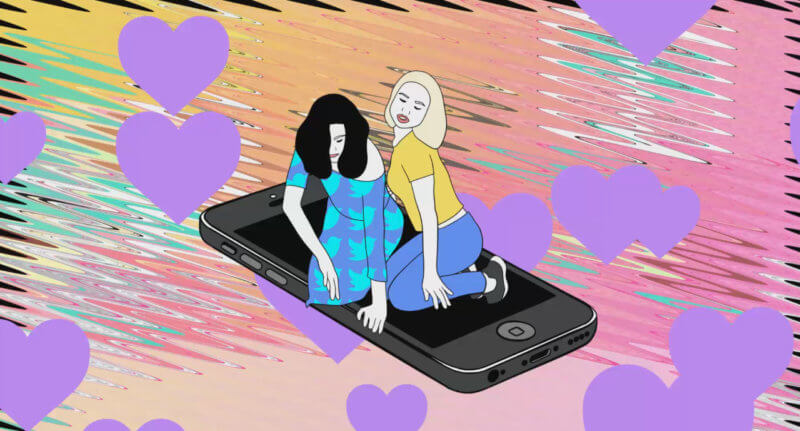
#21xoxo (Dir. Sine Özbilge/Imge Özbilge)
Was the film independently produced or were you able to secure funding/resources to help get it made (or was it made as part of an existing initiative)?
#21xoxo started evolving more than 3 years ago. I entered a competition and was selected for a workshop of the VAF (The Flanders Audiovisual Fund) to develop a project proposal. This selection made it possible to work on my idea for 6 months. I was guided by my mentor Han Hoogerbrugge, an astounding artist and great human being. Throughout the process I already started reflecting on the subject together with Imge. As my partner in crime, she always gave the most honest and sincere feedback. When the project finally had matured, we contacted Annemie Degryse from Lunanime and she agreed to a meeting. I still remember that day. Now I can see how important that day was, as we found a second home in one of Belgium’s most valuable production houses. Lunanime has a strong focus on art-house production and is a real creative hub for both Flemish as well as international productions. The making of this film became possible thanks to Annemie and Lunanime’s support and the funding that we received yet again from the VAF.
Further to that, I’m curious about The Flandriens of Animation – is this a single organisation or a collective of regional studios/producers? And can you elaborate on the role they played in bringing the film together?
The Flandriens of Animation is an initiative of Screen Flanders and started as a spotlight on the Flemish animation industry during Cartoon Movie 2017. Established production houses from Flanders and influential figures of the Flemish animation industry participated. A few selected young talents were also invited to represent the younger generation of upcoming directors. We were among those lucky few with other creatives such as the very talented Nienke Deutz. Screen Flanders itself was launched in April 2012 by the government of Flanders as a new economic support measure for audiovisual works. The Flanders Audiovisual Fund (VAF) manages the applications and promotes the fund.
So, Screen Flanders and VAF are the main funders of #21xoxo, while The Flandriens of Animation is the collective to which the team of #21xoxo belongs to.
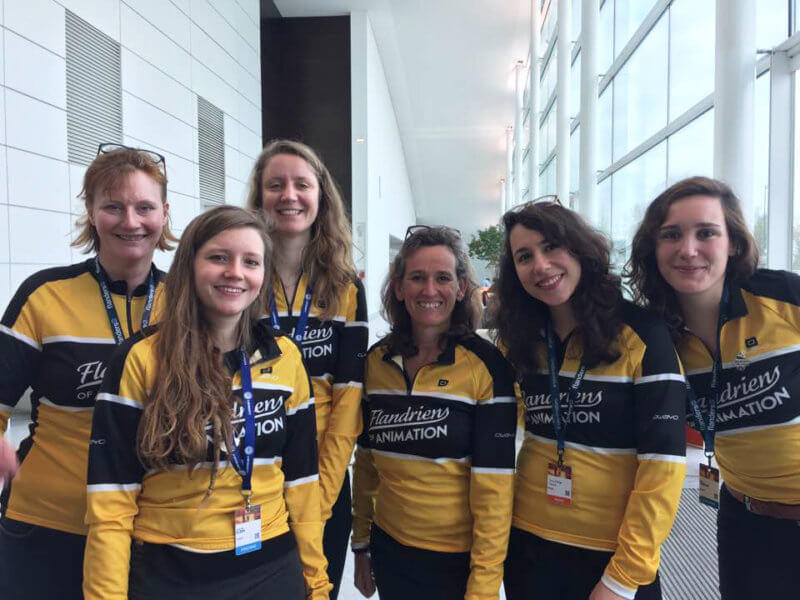
Flandriens of Animation
What prompted the idea of taking on the marriage of dating and the digital age for a short film?
Initially I was working on a love story that revolved around two characters. As the project progressed, many sublayers and multiple characters were added to the narration. I choose to bring cyberspace into it for several reasons. One of those is the fact that digitalisation is changing our lives, especially our love-lives. Love is a fundamental human need, something that all humans long for, in one form or the other. It fascinates and terrifies me at the same time how we happily sprinkle colourful algorithms and fabulous filters on our hearts, while waiting for that one right swipe.
Were there any specific influences on the look and style of the film?
My previous film was in black and white, so I was kind of craving to have more colour in my life. That meant that I had to invent a fresh artistic style. As you already guessed spot on during our Q&A at the Encounters this year Ben, one of my early inspirations was Hotel E by Priit Pärn. My mentor Luc Degryse from KASK introduced me to this wonderful work which left a powerful impression on me.
I have also been inspired by Surrealism and Pop Art in general, two very colourful and fantasy driven art movements that have become a fundamental part of my artistic expression. From Dalí to Dorothea Tanning, Warhol to Claes Oldenburg. My appreciation for these forms of art brought the desire to work together with other intriguing contemporary creatives. The two upcoming Belgian artists Kasper De Vos and Wim De Pauw generously collaborated on the live-action scene with their striking artworks the sandwich ‘Smoske’ and the painting Shape of Things to Come. And last but not least, Lewis Carroll’s Alice in Wonderland. Alice is for me a recurring inspiration and guides me through most of my artistic endeavours. You can see her presence also in my previous film The Three Ring Circus.
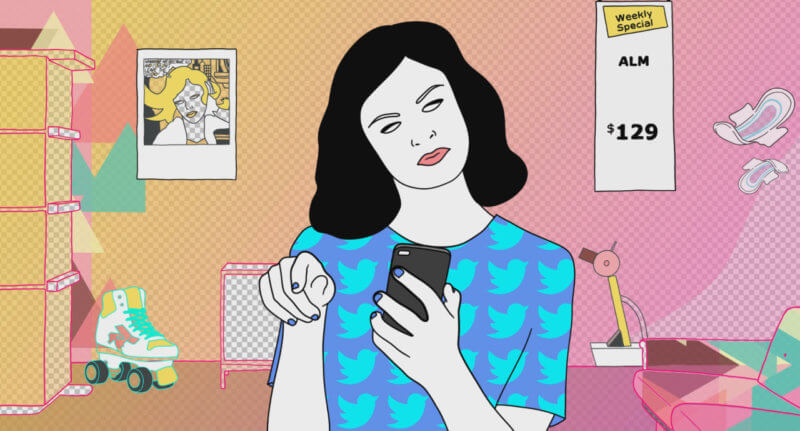
#21xoxo (Dir. Sine Özbilge/Imge Özbilge)
From a technical standpoint, what were the main softwares/processes you used to create the visuals for the final film?
We used a mix of 2D animation and rotoscoping with vector based animation programs. My main goal was to translate modern video clutter such as footage shot from smartphones, Skype frames, surveillance tapes, GoPro takes etc. into the medium of animation. These video aesthetics are a predominant part of our current visual culture and were essential in order to create the contemporary atmosphere of #21xoxo.
In my short films I experiment with the use of mixed media in order to generate sub-layers, open endings and distorted realities. I wrote my master’s thesis around the mixed media use (live-action and animation) in the adaptations of Alice in Wonderland, ranging from examples such as Lou Bunin, Disney to Švankmajer. This led to the conscious choice to combine live-action, traditional animation and rotoscoping in #21xoxo and introduced the game of realities to the movie.
By filtering real actors through the deformations of animation I sought to enhance their surrealism, underlining the artificiality and influence of social media and cyber space. The inhabitants of #21xoxo are stuck in a sort of cyber-real limbo between our actual world and cyberspace. As hybrids they neither fit into the rules of live-action, neither of classical animation. This is also a reference to our daily lives where we demonstrate a sort of schizophrenic existence floating in between our real selves and our online avatars, Facebook profiles and Instagram-selfs.
As well as its main theme of modern romance the film is a sometimes chaotic celebration of both popular and counterculture. What was your process for bringing together and arranging these visual elements?
Just like the film itself, the making of it was also quite chaotic. At times I worked very intuitively and experimentally. A lot of personal interests fused together with the extensive research I did on social media and post-net phenomenon.
My daily scavengings through the clouds and rainbows of the internet played definitely a major role in the process. Sometimes I came across amazing finds, while at some other moments I stumbled upon oddities and disturbing discoveries. Cyberspace is a magical place where all things human are augmented to a maximum.
Slowly the style started to take shape. My background in graphic design definitely brought a graphic and pop-art look to the post-net topic. References to design history and contemporary art culture sneaked in through the back door, including an Ettore Sottsass lamp and a Lichtenstein painting. The characters became colourful and lovely, yet void of emotion, hence the lack of pupils and the use of text-to-speech dialogues. The protagonist girl literally came to life somewhere between the rectangular tiles of Photoshop and a virtual Ikea showroom, running through Vaporwave screens with each swipe.
Regarding the Internet references, I tried to incorporate a wider timeframe of the post-net era. Born in 1990, I witnessed some of the early developments. I remember my parents chatting on ICQ and receiving my first mobile phone – the size of a brick with an orange teddy bear cover. It is fascinating how quickly the internet grew and conquered the world. I have to say that I already often feel outdated myself even though I’m just turning 30. I wanted to make #21xoxo accessible and enjoyable for as many people and generations as possible.
The credits list an enormous amount of found footage attribution. Did you have a specific process for selecting clips and keeping track of it all?
Yes I did. After seeking images according to the connotations they would generate within the world of #21xoxo, I started looking for the definite visuals. Of course their licences had to be under the creative commons guidelines. It took quite some time to find the correct and legal material. I included all of the images in the credits, even though a lot of them have a CC0 licence and do not even ask for accreditation. As a maker of visuals myself, I believe that it is important to respect and credit other people’s work. So that is why the list is so long 🙂
Some of the images have a lot of humour and refer to specific subjects. One of my favourites is an artwork of Olia Lialina; one of her ‘Animated GIF Models’ of herself is included in the scene with the rabbit. She is a pioneering internet artist and theorist and brilliantly devoted this work to the public domain. Including this piece in my movie is an homage to her and shows my deep appreciation.
Did you also take the reins on the post-productions side of things?
Yes, I did. I was involved in every step of the making. I even animated a large portion of the film myself, but of course I couldn’t have done it without my talented animation team. It’s really fun to collaborate with other creatives on the ideas that you have.
For the music I worked together with my husband Remco Weyns, who is also a professional musician. I had a very clear idea from the beginning. The music had to be composed of social media sounds. Sound is a very powerful tool that can aid you in creating the atmosphere that you want in your film. So we spent countless days in his studio experimenting. It was amazing how Remco translated the concept into a series of soundtracks.
For the Sound Design we collaborated with Thomas Vertongen. When we met, it was as if Thomas was reading my mind. He really understood what the film was about and brought impressive creative input to it. I strongly believe that his skills played a crucial role in binding the scenes and in giving the movie the fluidity it needed.
As for the editing, here I took things really into my own hands. I was obsessively trying out different cuts, montages and SFX for a prolonged period of time. Often to an extent where I could not see clearly anymore what worked and what did not. Imge was my rock throughout this process. Having someone so close to your vision with a fresh take on things was absolutely amazing. Eventually we managed to bring all the pieces together. I wanted a fragmented yet still continuous visual experience, just like the fragmented yet flowing experience of social media with ‘reading posts’, ‘swiping on tinder’, ‘cruising on Instagram’ and so forth – brief glimpses between narration and abstraction.
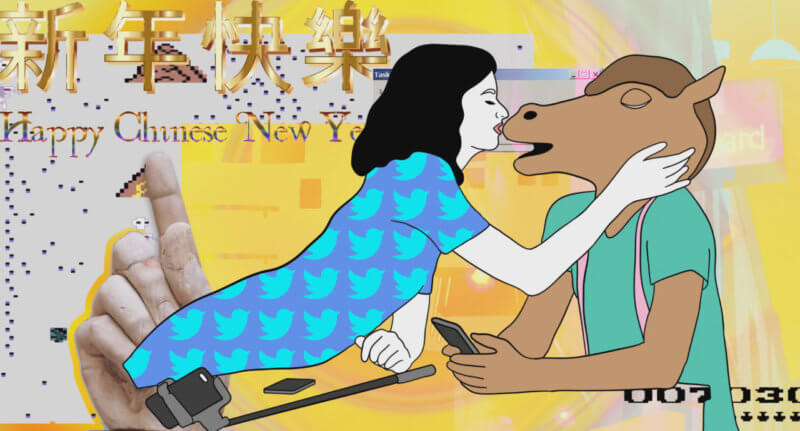
#21xoxo (Dir. Sine Özbilge/Imge Özbilge)
There’s a great deal of rotoscoped character work that seems to be spread across three main performers. Were there any challenges when it came to directing the actors in person and did they have any frame of reference for how the film would eventually look?
That’s a fun question. The shoot for the rotoscope part was really entertaining. I gave my actors an introduction to the topic with some visuals and explained to them what would happen to their real selves once we’d start the animation. I don’t think they really could imagine exactly how it would look like but the idea to transform into drawn characters in some sort of colourful cyberworld was exciting.
Indra De Bruyn and Darya Gantura played the female protagonists. Steven Boen played all male figures, transforming from a sleazy beach boy to a selfie loving stallion. His part was definitely the most schizophrenic and challenging. To aid him with his transformations I brought some props, costumes and masks to the shoot. The most amusing shot was probably the one where he’s swinging a GoPro on a string around himself and Indra while wearing a penis mask.. You can imagine how hilarious that was to act and to watch! They danced to poppy music, licked mirrors and pretended to walk through screens. It was absolutely amazing. I’m very grateful for their trust and talent, as at times it was difficult to imagine what all this crazy stuff was going to turn into.
For the girls, the trickiest part was to lip synch the text-to-speech audio fragments that I had prepared in advance. Not only did they have to have the exact right articulation, but they also had to act simultaneously. They truly did a remarkable job and all three of them brought a lot of character and charisma to their animated alter egos.
Toward the end of the film the energy of the visuals gets increasingly extreme and eventually reaches fever pitch (warranting a seizure warning at the beginning of the film) – what would you say this particular sequence represents?
The ending sequence of the movie is deliberately more abstract and fragmented and is constructed to be open to interpretation. I think it’s beautiful that every individual can draw their own personal conclusions from it. This can generate a lot of interesting dialogues within the audience, so instead of giving an explanation I would like to quote a paragraph from David Lynch’s book Catching the Big Fish:
‘Someone might say, I don’t understand music; but most people experience music emotionally and would agree that music is an abstraction. You don’t need to put music into words right away – you just listen.
Cinema is a lot like music. It can be very abstract, but people have a yearning to make intellectual sense of it, to put it right into words. And when they can’t do that, it feels frustrating. But they can come up with an explanation from within, if they just allow it. If they started talking to their friends, soon they would see things – what something is and what something isn’t.’
Earlier work you have posted online (such as 80s Promo and Loop-o-gram of PostNet Attitudes) seem to be a precursor to #21xoxo – were these initially created with an eventual longer film in mind or did that concept come afterward?
The 80s Promo was a commissioned work for the Gent-based museum Huis van Alijn. They asked for an animated short for the launch of their 80s chamber. The museum itself has a vast archive of footage of Gent from different timeframes. I used videos from Gent in the 80s specifically in combination with iconic elements of those years.
Loop-o-gram on the other hand was indeed a series of experiments that functioned as a precursor to #21xoxo. Short manifestations of ideas in animated fragments and bits of sound.
As well as your own projects do you also work together on professional commissions (and are there any you’re particularly happy with)?
We both have worked on commercial projects individually but so far we collaborated on artistic projects mainly. I’m very fond of the latest animated installation we made for the exhibition Growlers, Cracklers & Bursters at the CIAP Arts Center in Hasselt curated by Frederik Vergaert.
The work #02 is the continuation of our initial collaboration with the title #01 and started back in 2017. We attempted to fuse our idiosyncratic styles. It is an experimental study in which two individual visual worlds collide. We started by focusing on differences and then continued by observing our similarities. Subsequently through an effortless, often unconscious assimilation we brought our individual practices and concepts into a state of osmosis. The result was a mutual focus on the subject of femininity. The selection of concave figures and the exclusion of convex shapes have led to the creation of an obscure dreamy world of feminine dominance.
Together we experimented with the traditional form of the art of animation, while simultaneously playing with the relation of animation and the 16:9 screen. The piece was brought alive with sounds composed by Remco Weyns.
The exhibition itself was curated around sound and movement, based on one of the early works of the futurist artist Luigi Russolo. It was quite amusing to contribute to a futurist expo with a predominantly female artwork. A nice touch from Frederik’s side.
That said, we are always open to interesting commissions and would definitely enjoy working on them.
Are there any upcoming projects you are working on, either together or individually, that you can tell us about?
The next project that will meet the public will be our upcoming short Mosaic. The project is in production at the moment. We are planning on releasing it coming spring. The story is written and created by Imge and I am co-directing it. This time, we will take the audience into a world with a very hand-crafted visual style, following the story of three characters living in the oldest city of the Middle East. I’m so excited to be part of this project and can’t wait to see the first results.
#21xoxo screens at LIAF in International Competition Programme 3: Playing with Emotion 8:45pm November 30th at the Barbican. For updates on the film you can follow its Facebook page.
You can hear more from Sine Özbilge and Remco Reyns in our recent filmmaker Q&A session at the Encounters Film Festival in Bristol (direct download or stream below):


